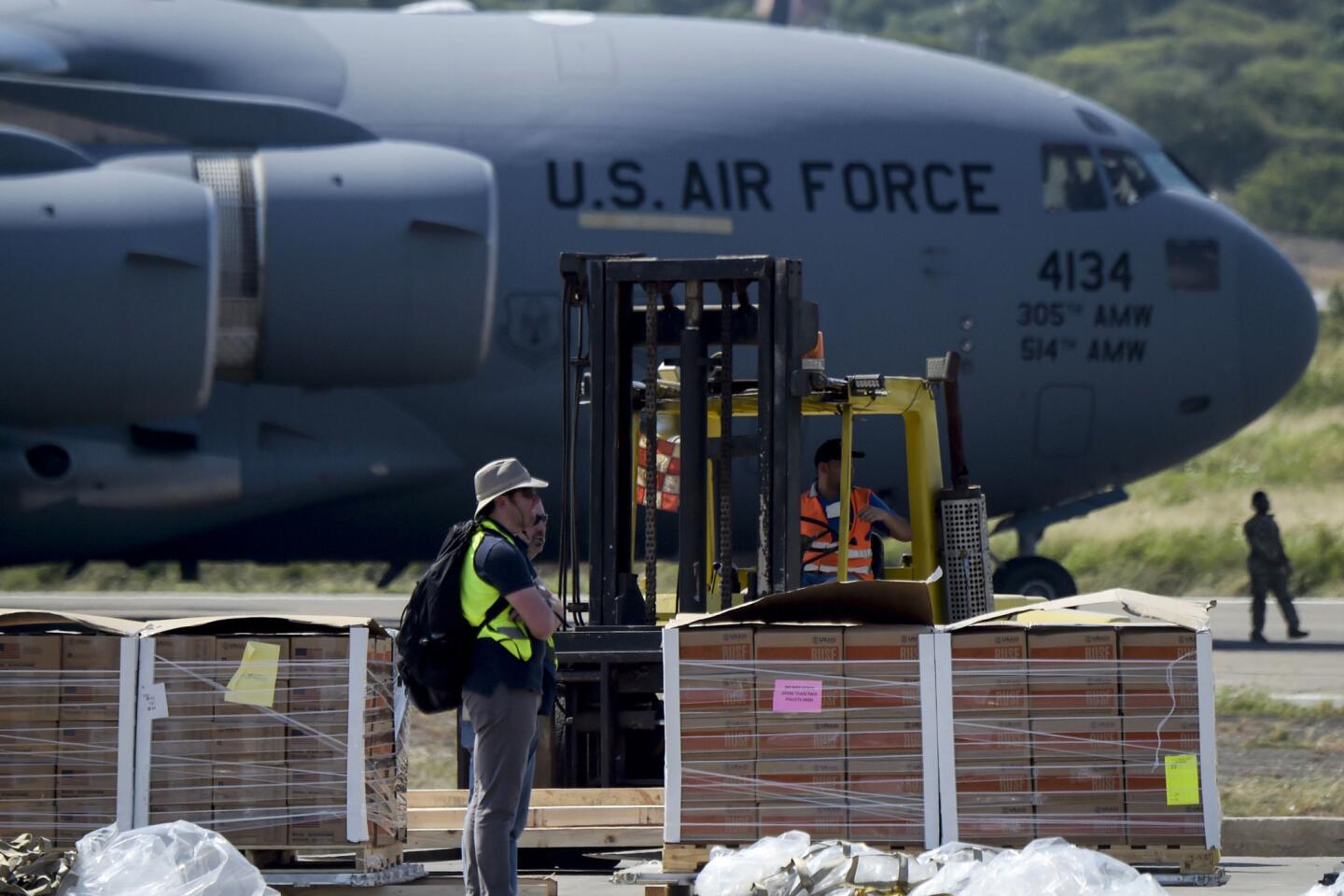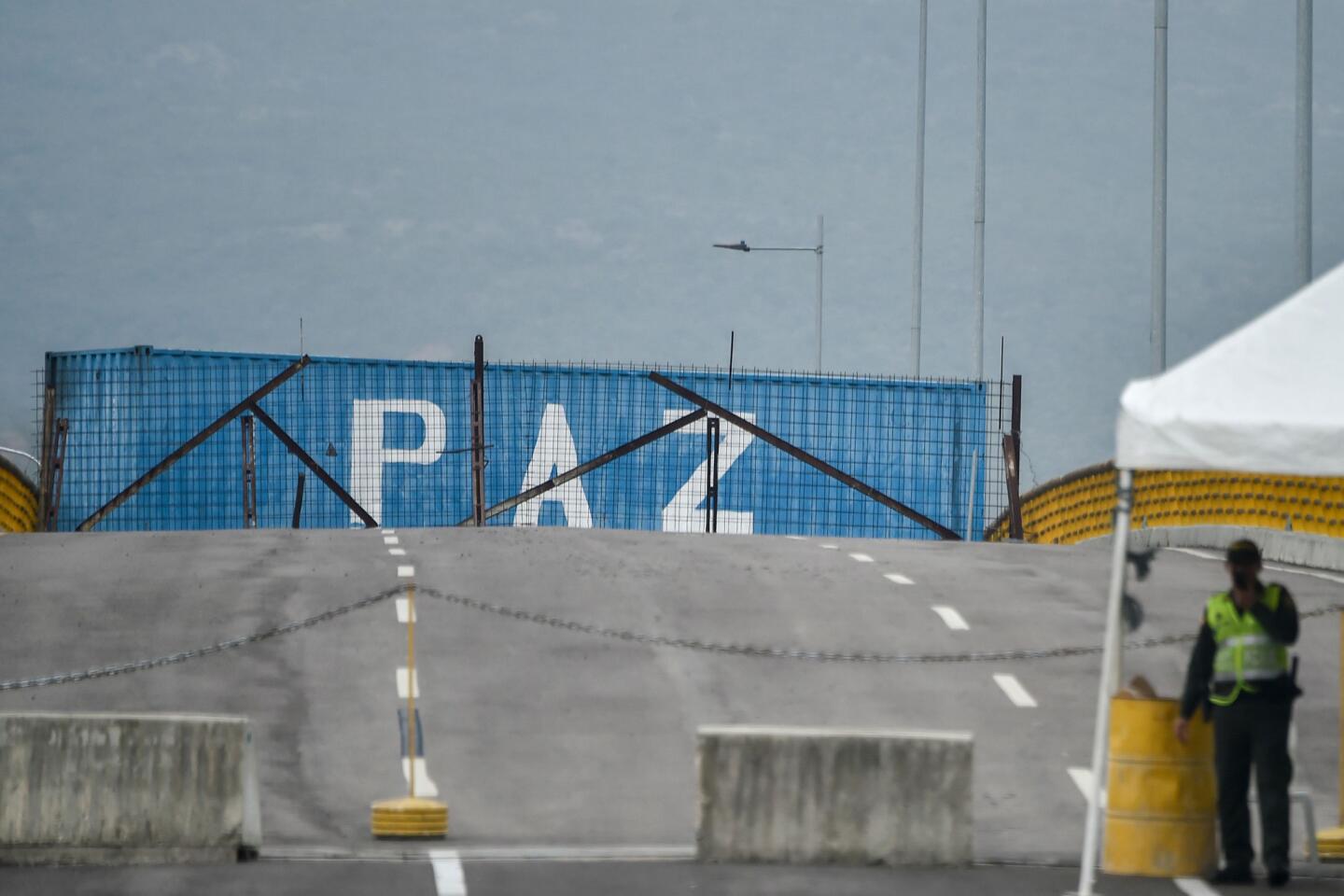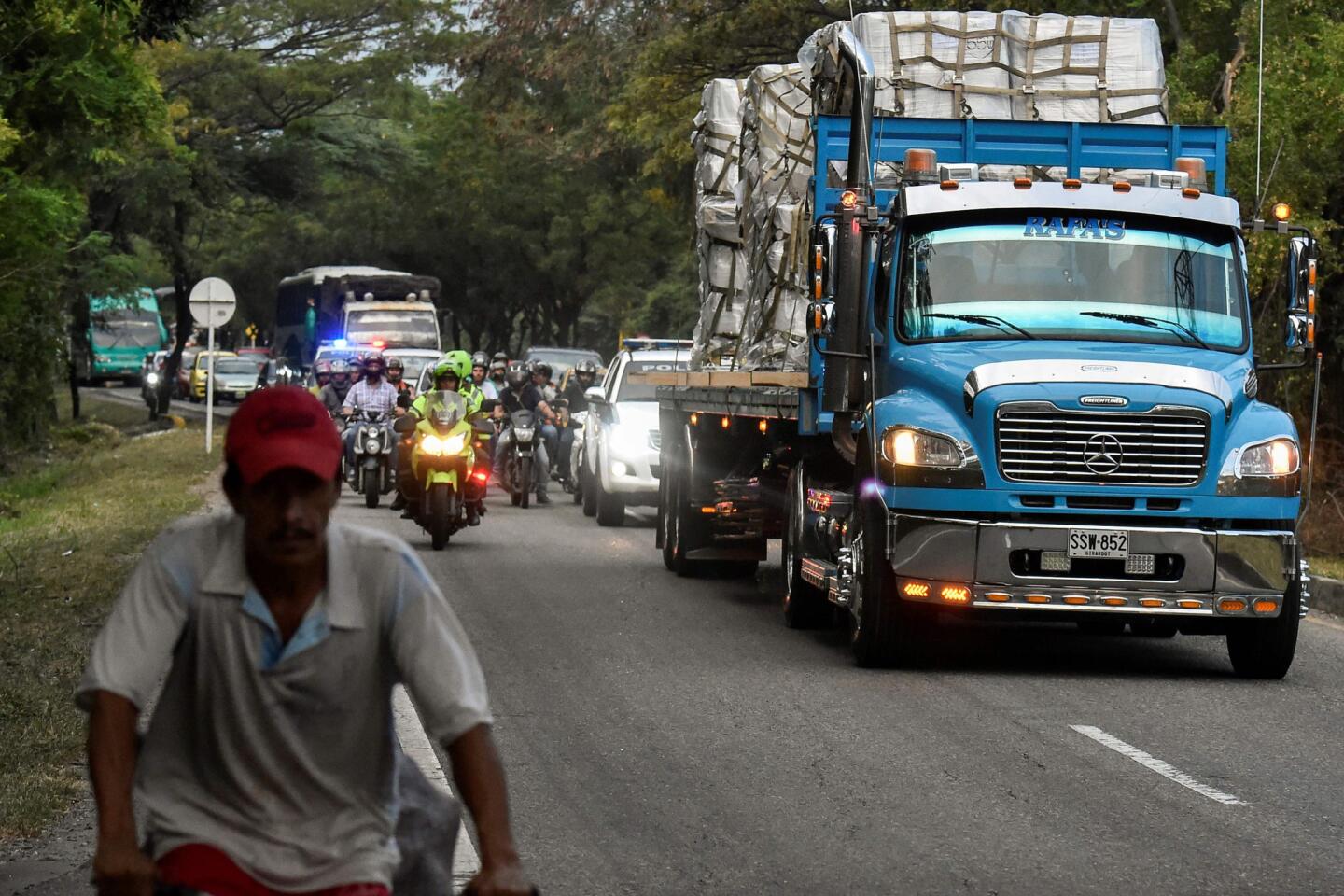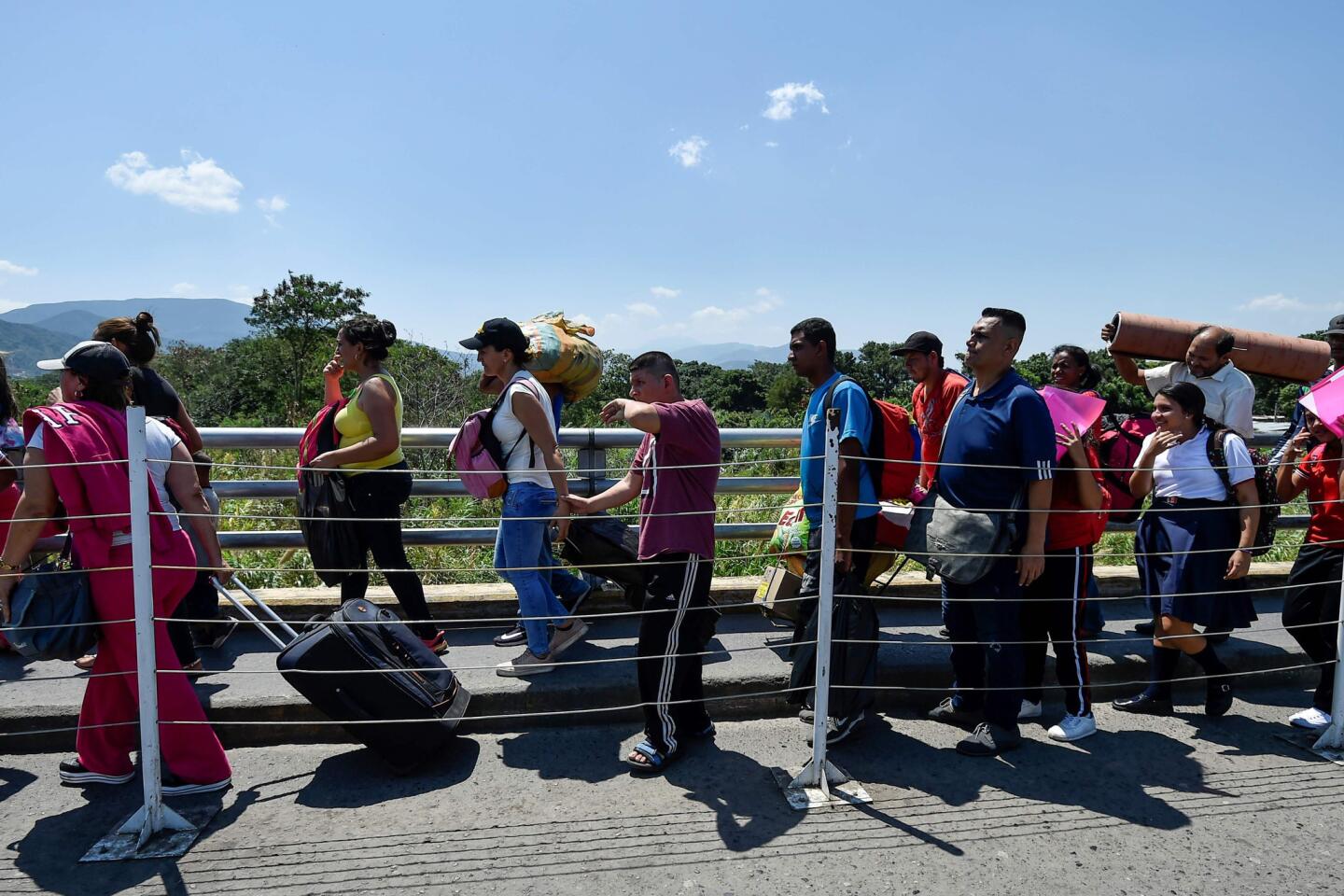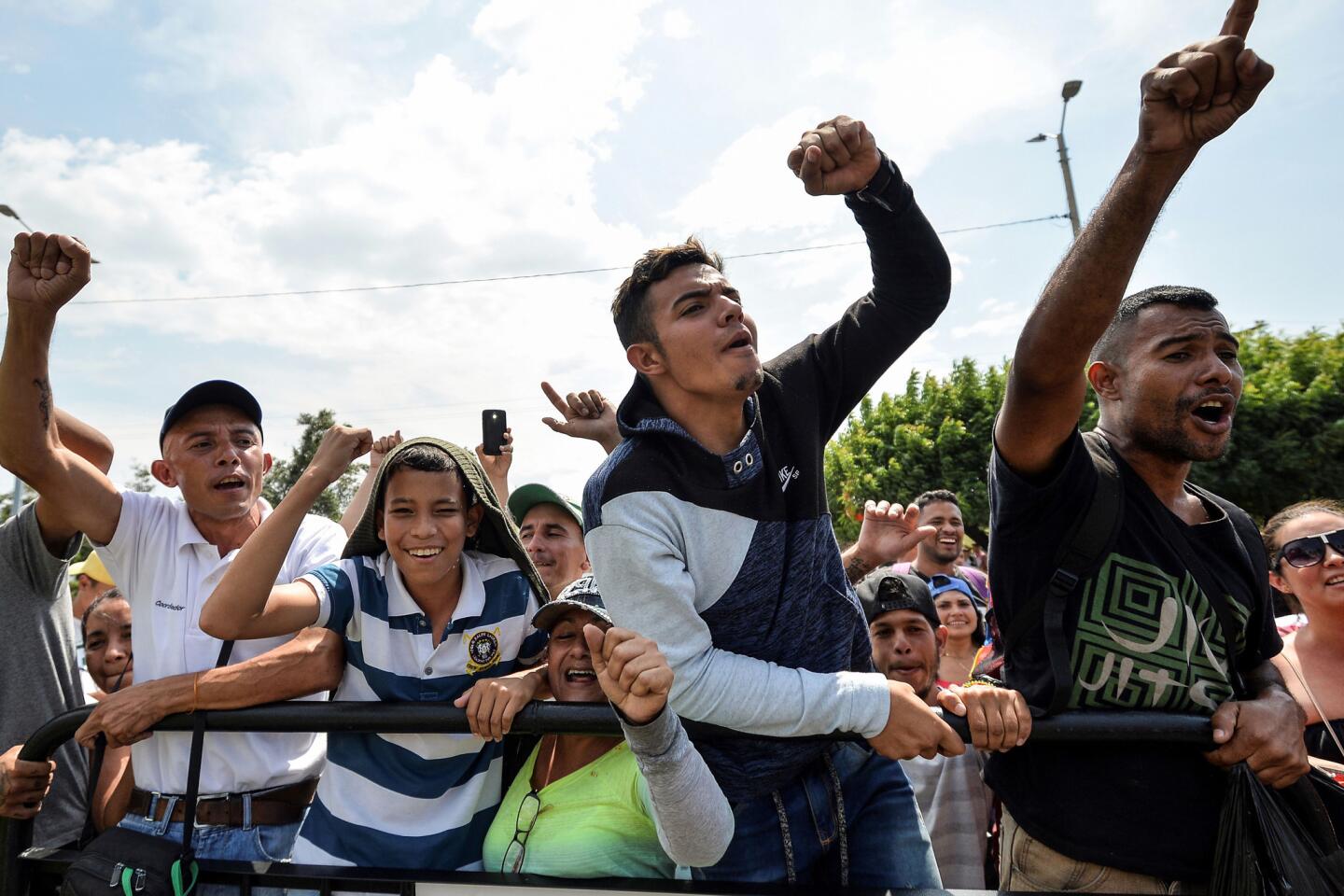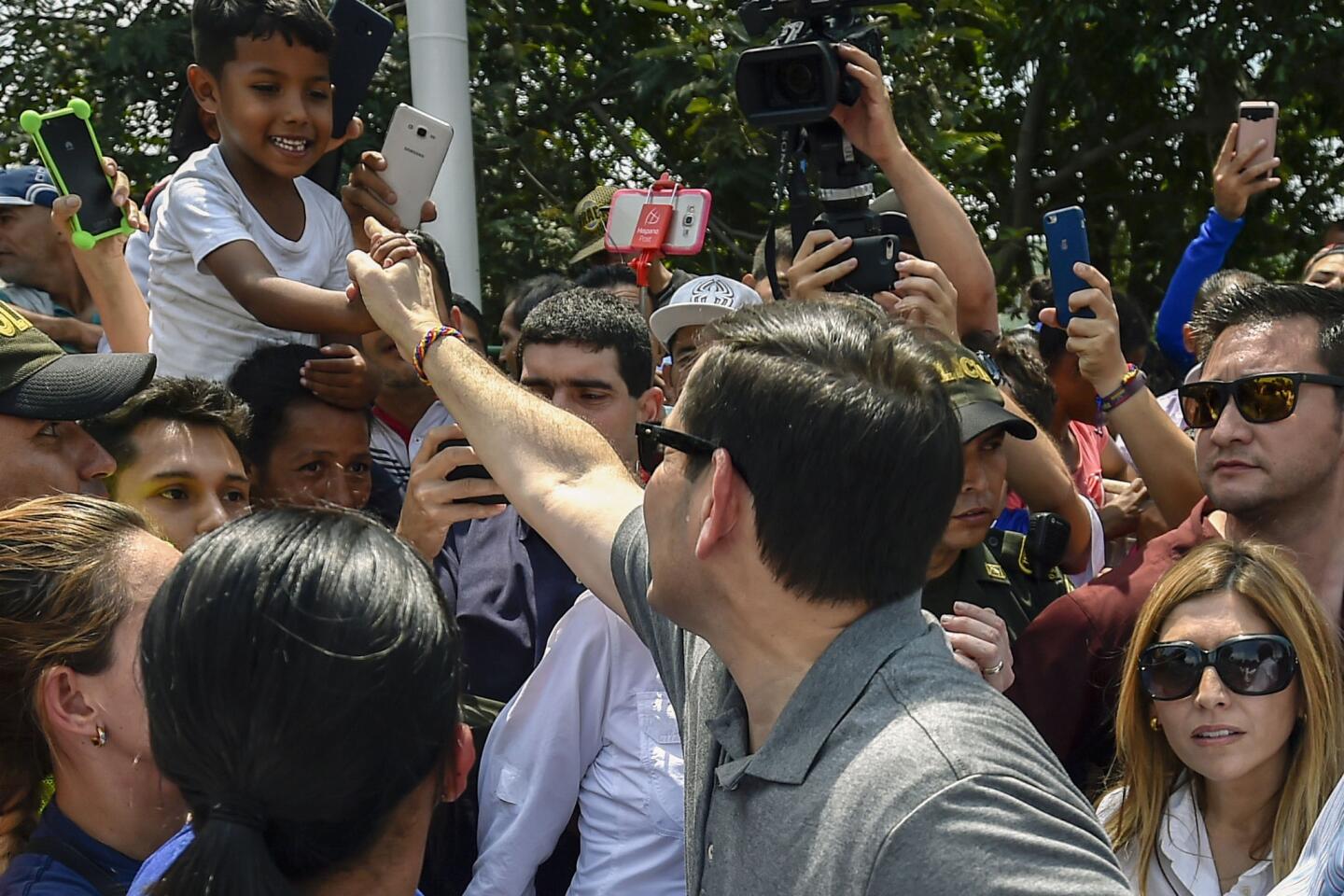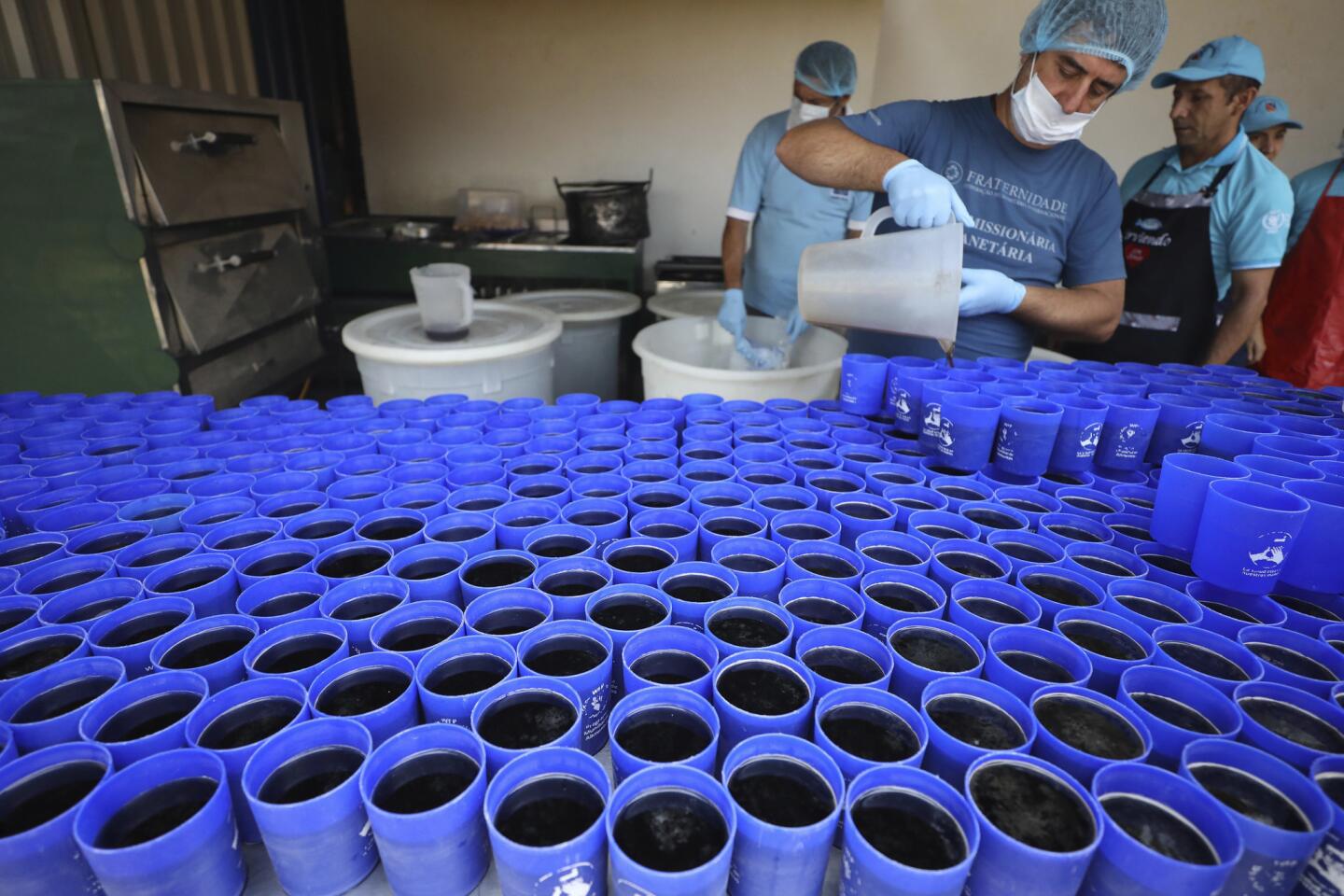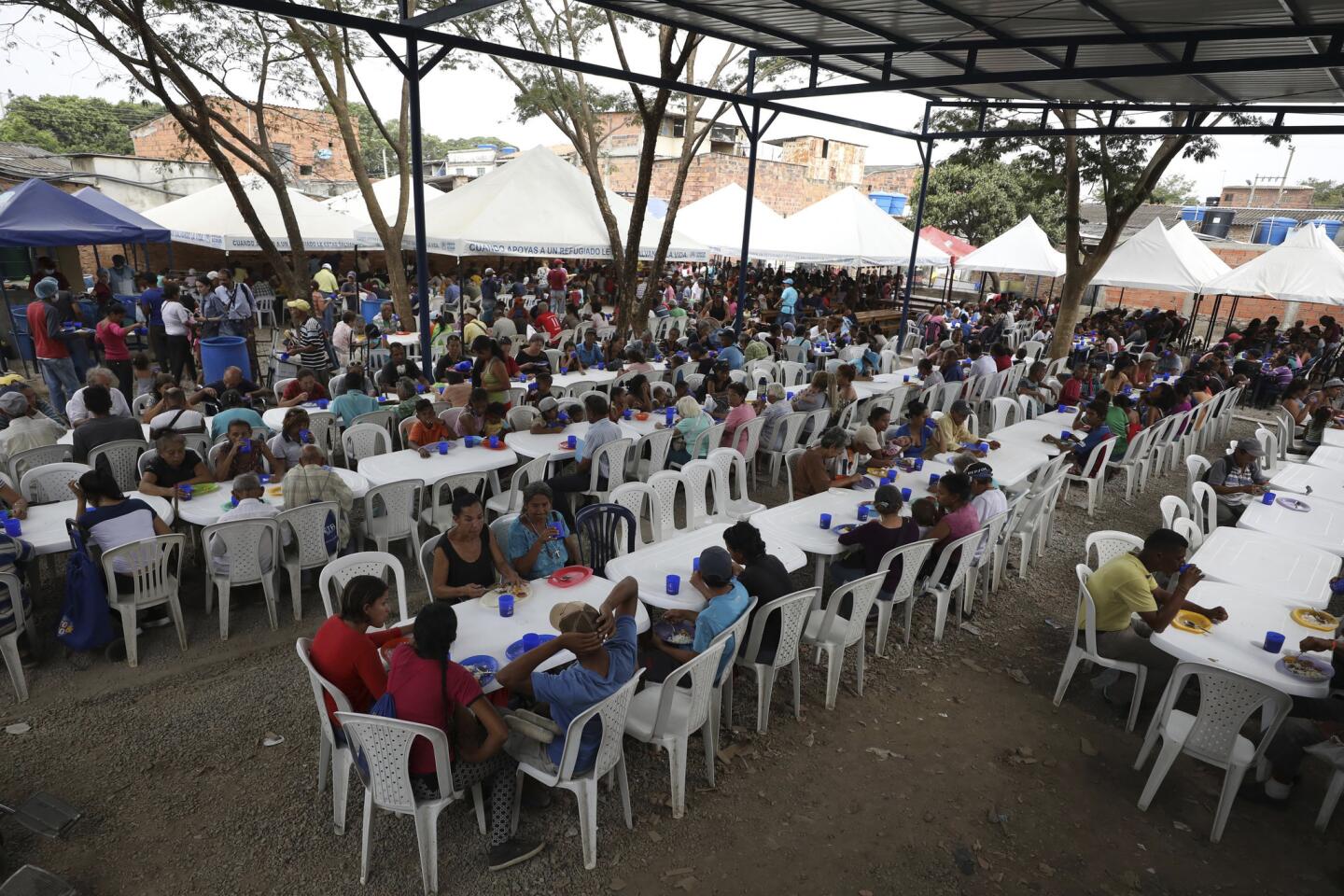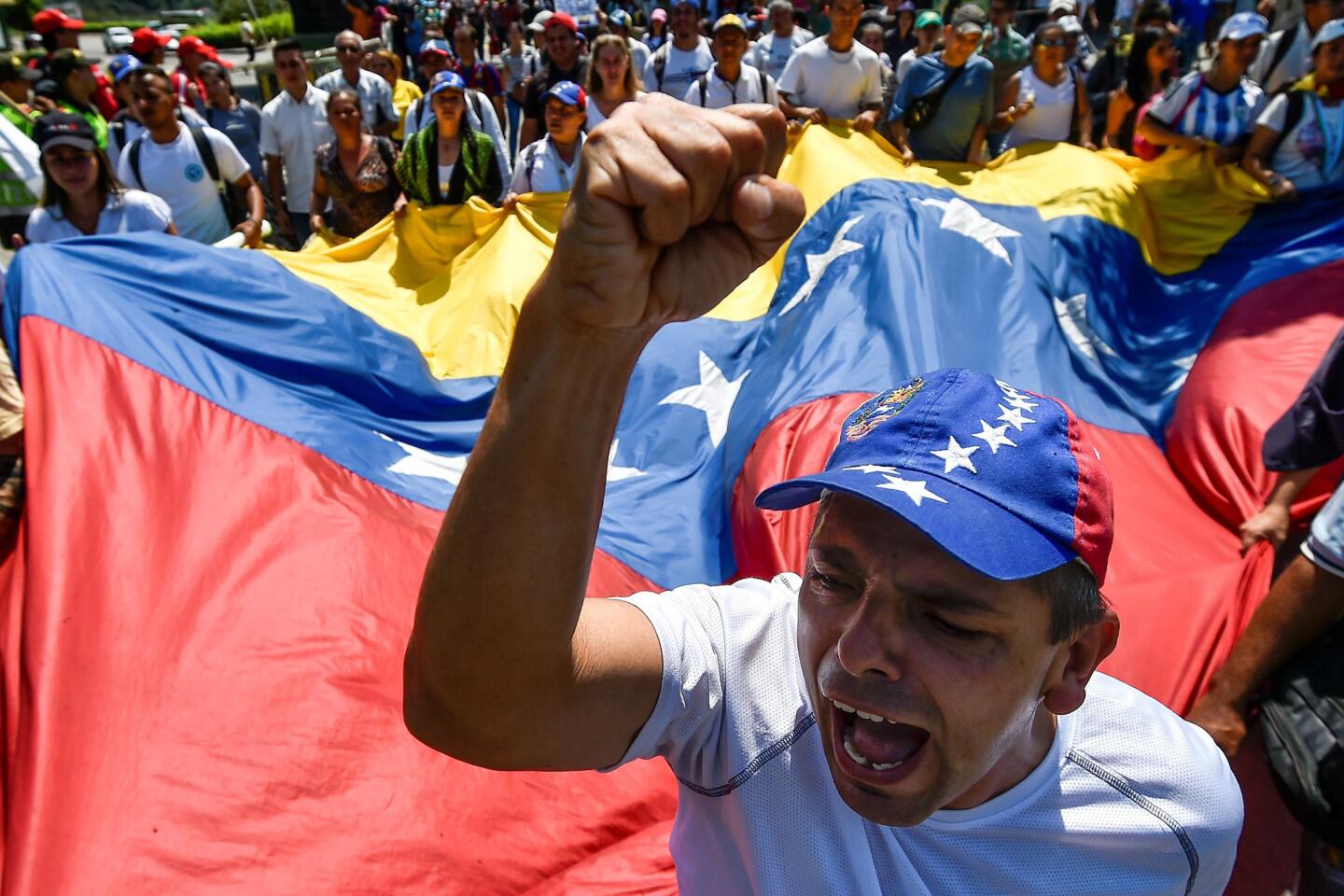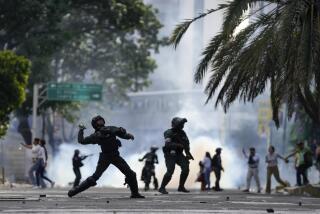30,000 Venezuelans cross into this Colombian town each day. Now it’s the scene of an escalating aid showdown
- Share via
Reporting from Cucuta, Colombia — For the beleaguered people of Venezuela, this Colombian border town has served for years as a kind of safety valve — a way station en route from their reeling homeland, or a place to score food, medicine and other basics no longer available in Venezuela.
“I came to get vaccinations for my daughter,” said Almari Ruiz, cradling her 11-month-old, Victoria, as she moved forward with the throngs crossing the Simon Bolivar International Bridge on a recent afternoon. “It’s hard to find them anymore in Venezuela.”
Each day, authorities say, more than 30,000 pedestrians cross from Venezuela into Colombia; most are on subsistence shopping forays, but many are joining the exodus of millions who have given up on their homeland and emigrated elsewhere in recent years.
Now, however, as the Venezuelan crisis escalates, Cucuta has taken on a broader geopolitical role — as a symbolic and logistics hub for intensifying U.S. efforts to oust Venezuelan President Nicolas Maduro and his socialist government.
Diplomats, activists, journalists and others have descended on this tropical city of 800,000, which has long had a symbiotic relationship with neighboring Venezuela — the town’s economic fate shifting with boom and bust cycles across the border.
Dueling aid concerts with deeply political subtexts are scheduled for this weekend on both sides of the international line.
“The whole world is now watching Cucuta,” said Felix Adolfo Muñoz, who heads the mayor’s crisis management team, which has been scrambling to beef up security and infrastructure and otherwise deal with the onslaught and attention.
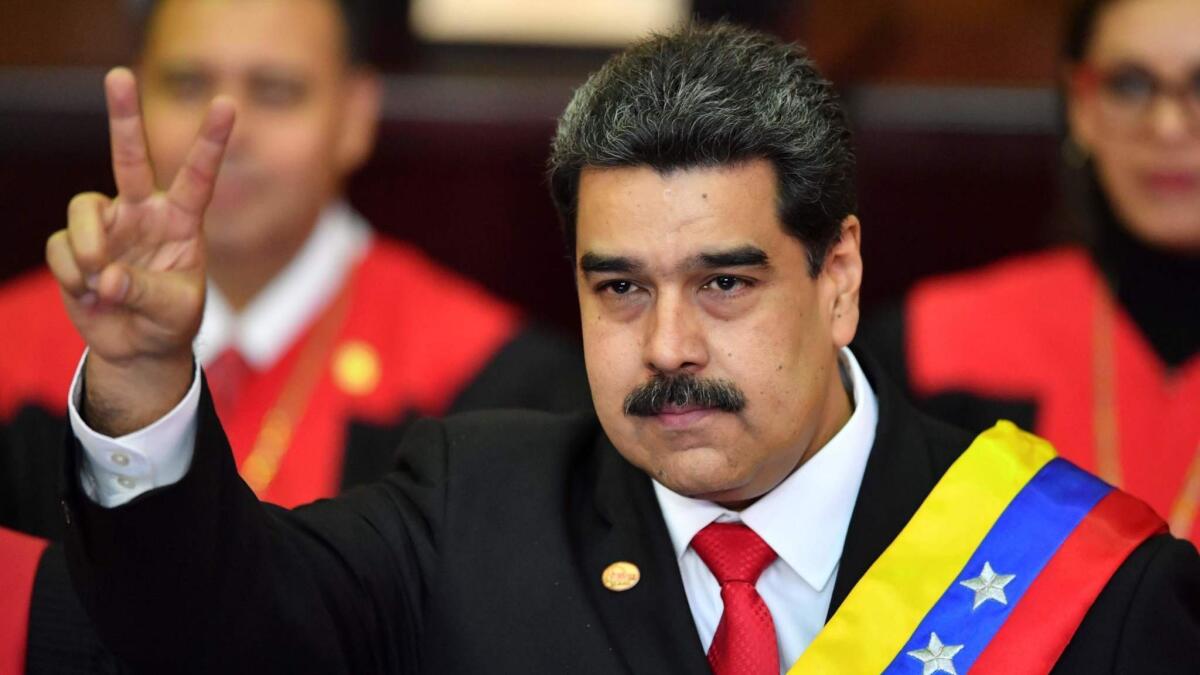

While the Trump administration has employed diplomatic pressure, economic sanctions and even hints of military action in its bid to force out Maduro, the weapon of choice in Cucuta, at least for now, is an unlikely one — humanitarian aid, lots of it. A showdown on blocked U.S. aid looms this weekend.
The White House has cast aside criticism that it is employing aid as a strategic cudgel to force the exit of Maduro, who has called the assistance a prelude to a U.S. invasion and vowed it will never enter Venezuela. Instead, the Trump administration has doubled down on the tactic of using aid as a lever.
That venerable aid providers including the Red Cross and United Nations have declined to become involved — respecting the traditional separation between humanitarian aid and politics — has not damped the Trump administration’s enthusiasm for the gambit.
The White House calculation seems to be that the Venezuelan military — whose top brass has reaffirmed its allegiance to Maduro’s government — will be somehow shamed into opening the border and defying its commander in chief. That would essentially signal a breakdown in military allegiance, and possibly the beginning of the end of Maduro’s rule.
How likely that scenario is remains a question mark. But the White House is orchestrating an intense public relations effort.
Last weekend, before assembled TV cameras and a welcome committee of U.S. and Colombian officials and opposition-allied Venezuelans, U.S. Air Force C-17 cargo jets began ferrying hundreds of tons of Venezuela-bound food and medicine into the airport here.
The aid is being stockpiled in warehouses at the entrance to a long-unused bridge to Venezuela.
Juan Guaido, the Venezuelan legislative leader and self-proclaimed interim president, whom the United States and allied nations recognize as the country’s head of state, insists the aid will enter Venezuela on Saturday.
Getting the aid in has become Guaido’s rallying cry and the first real test of a self-declared leader who controls no territory or government infrastructure. It’s still not clear how he expects to get the aid in, though he has called on volunteers on both sides of the border to rally to the cause.
The Venezuelan government has shown no sign of relaxing the blockade on its side of the bridge.
“It’s a rotten gift; it’s a deceitful package,” said Maduro, who blames a U.S. “economic war” against Venezuela for causing shortages of food and medicine — while critics and Washington blame his government’s mismanagement and corruption. “The package is very pretty from outside, but inside it brings the poison of humiliation.”
Meantime, British billionaire Richard Branson has announced plans for a Live Aid-style benefit concert here Friday, with the aim of raising $100 million for destitute Venezuelans. The effort, Branson said in a YouTube video, is at the request of Guaido and his opposition mentor, Leopoldo Lopez, currently under house arrest in Caracas.
But the Venezuelan government, viewing the aid scheme as a publicity ploy and provocation, is mounting its own mocking response.
On Monday, Venezuela announced that it planned an “immense,” two-day concert on the international bridge here with the dual theme: “nothing for war, and hands off Venezuela.”
People sell the last thing they have — silverware, wedding rings, whatever. It’s sad, yes, but it’s the reality of Venezuela today.
— Cesar Perez, former Venezuelan air force sergeant buying gold and silver
Caracas also says it plans to hand out some 20,000 boxes of food staples to the people of Cucuta, while also offering to bring doctors to the border to provide free medical care to residents here. Maduro has long denied that Venezuela faces an emergency and said poor Colombians in the Cucuta area need the aid more than Venezuelans.
The spectacle of the international aid standoff has not altered this city’s daily routine, which revolves around the daily flow of people back and forth across the border. The scene at the Simon Bolivar International Bridge provides a snapshot of the pauperization of Venezuela, once among South America’s richest nations.
Vendors on the Colombian side hold up signs offering cash for bits of gold or silver, even hair.
“People sell the last thing they have — silverware, wedding rings, whatever,” said Cesar Perez, a former Venezuelan air force sergeant who was soliciting gold and silver. “It’s sad, yes, but it’s the reality of Venezuela today.”
The Colombian side features a vast collection of market stalls and street vendor stands, selling potatoes, diapers, toilet paper, tires and Venezuelan cigarettes, among other items. Most vendors, and clients, are Venezuelan; some cross for the day, but others have moved here.
Roving salesmen hawk a range of antibiotics, generally available for the equivalent of 3 U.S. cents per pill or tablet — no prescription required.
“We come regularly to get heart medicine for my mother-in-law,” said Custodia Castellanos, 42, who showed an array of medicine purchased from various border pharmacies. “She is 72; she would die without it. And we can’t get these in Venezuela anymore.”
The vast array of items — including many made-in-Venezuela products smuggled across the border — are no longer found in Venezuelan shops and markets, or are prohibitively expensive in a country where the currency has collapsed and the minimum wage is the equivalent of about $6 a month.

Many customers travel from as far as Caracas, a 13-hour road trip, to stock up on staples. Some Venezuelan communities send weekly or biweekly delegations here to buy essentials.
“We have three kids; these are things we need, and they are too expensive in Caracas,” said Robert Montana, 44, who makes regular trips from the capital with his wife to purchase bulk items such as toilet paper, flour and rice.
Money changers do a brisk business speculating on the hyperinflation of the Venezuelan bolivar, with its ever-spiraling decline in value.
No one among dozens of Venezuelans interviewed in recent days seemed to object to the U.S. aid coming in. Haggard Venezuelans here and in Caracas are fed up — and many blame Maduro, saying life was much better under his predecessor and mentor, the late Hugo Chavez, who funneled record oil revenues into reducing poverty and raising literacy levels.
“Yes of course, let the aid in,” said Jose Abdon, 34, a Venezuelan who is among the many cart men, or carrucheros, who work the crossing.
The carrucheros rent dollies or carts for a dollar a day and offer their services to shoppers returning to Venezuela with packages of goods.
Abdon says he earns the equivalent of about $4 a day pushing his loaded cart back and forth across the bridge beneath the unforgiving sun. The money goes to support a wife and young daughter back in Venezuela.
“My daughter is one year and one month old,” Abdon noted, “and in her whole life we have only been able to buy one package of diapers. My wife has made do with rags and cloths.”
Years of industrial-scale smuggling and extraction of Venezuelan resources, especially gasoline, have contributed to the gutting of the country’s economy. Venezuelan gasoline, which is basically given away for tips at Venezuelan state-owned service stations, is smuggled into Colombia under the eyes of police and sold for prices similar to those in the United States.
Five-gallon jugs of Venezuelan gasoline are transported from the border by motorcycle-bound ferrymen known as pinpineros, after the gas-filled plastic containers attached to their bikes.
In 2015, Maduro closed the border crossings here, declaring that the contraband trade was bankrupting the country. But smugglers promptly switched to clandestine routes across the extremely porous, 1,400-mile border, sections of which are controlled by paramilitary groups.
Venezuelan patients have also overwhelmed Cucuta’s public medical center, Erasmo Meoz University Hospital. Venezuelans now account for about one-third of all patients, compared to less than 5% in 2012, said Dr. Juan Agustin Ramirez Montoya, the hospital’s director. They are concentrated in emergency-room and obstetrics services.
“I’m all swollen, and I want to find out if anything is wrong with my baby,” said Wendy Dayana, who is 34 weeks pregnant and among the many Venezuelan women who crossed the bridge and sought prenatal checkups at the hospital.
“A doctor in Venezuela told me, ‘Everything is fine, just go home,’ but that’s what they always say,” the 24-year-old said. “I don’t trust them. I want to be sure.”
Special correspondents Chris Kraul in Bogota, Colombia, Mery Mogollon in Caracas and Liliana Nieto del Rio in Cucuta contributed to this report.
Special correspondents Chris Kraul in Bogota, Colombia, Mery Mogollon in Caracas and Liliana Nieto del Rio in Cucuta contributed to this report.
More to Read
Sign up for Essential California
The most important California stories and recommendations in your inbox every morning.
You may occasionally receive promotional content from the Los Angeles Times.
